What follows is an extension of Part 2 of my interview with dancer-choreographer Rudy Perez. It’s not an interview but rather the thousand words that are hardly worth a (moving) picture. It’s an anatomy of the performance that first brought Rudy and me and my fellows together.
Urban Rite (aka Collaboration)
Forty years ago today Rudy Perez, David Moreno, Joseph Shuldiner, and I presented Urban Rite, a performance at Traction Gallery in the Little Tokyo neighborhood of Los Angeles.
David and Joseph were my loftmates in that sprawling space, the former Angeles Desk Company. Joseph and David finished a small portion of the open room, dubbed it TRACTIONgallery, and inaugurated it that February of 1980 with a performance by David titled Aqua (for which I did sound). The piece interwove mythology, astrology, clairvoyancy, autobiography, propinquity, and mutability into an ocular and sonic spectacle of that which is vital, powerful, yet virtually invisible: H2O. In the climax of the piece David shaved off his beard, which he’d probably sported for ages, and which had figured prominently in the work’s publicity. A year later, Rachel Rosenthal, with whom David had studied—and who was in the audience—lost her own locks in He Left Her in Naxos, a piece that premiered across the street from us at the satellite gallery of LAICA (Los Angeles Institute of Contemporary Art), an ambitious but short-lived arts institution.
Traction Gallery announced its rather ambitious summer schedule by the flyer below. Collaboration was a placeholder for the eventual title Urban Rite.
In July, Joseph held an exhibition titled Paper & Felt Pieces, which were sculptural and hinted at the constructions he’d produce later.
I followed up with Aches, an evening of sound pieces (on my birthday).
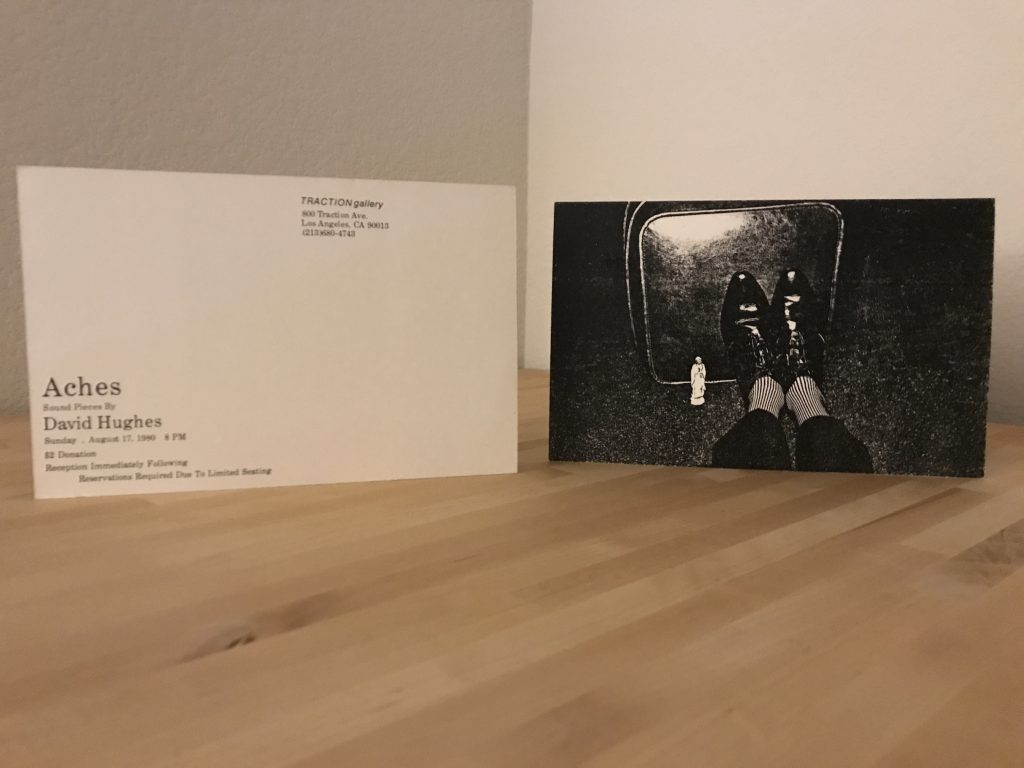
Urban Rite was six days later (on my wife-to-be Andrea Carney’s birthday).
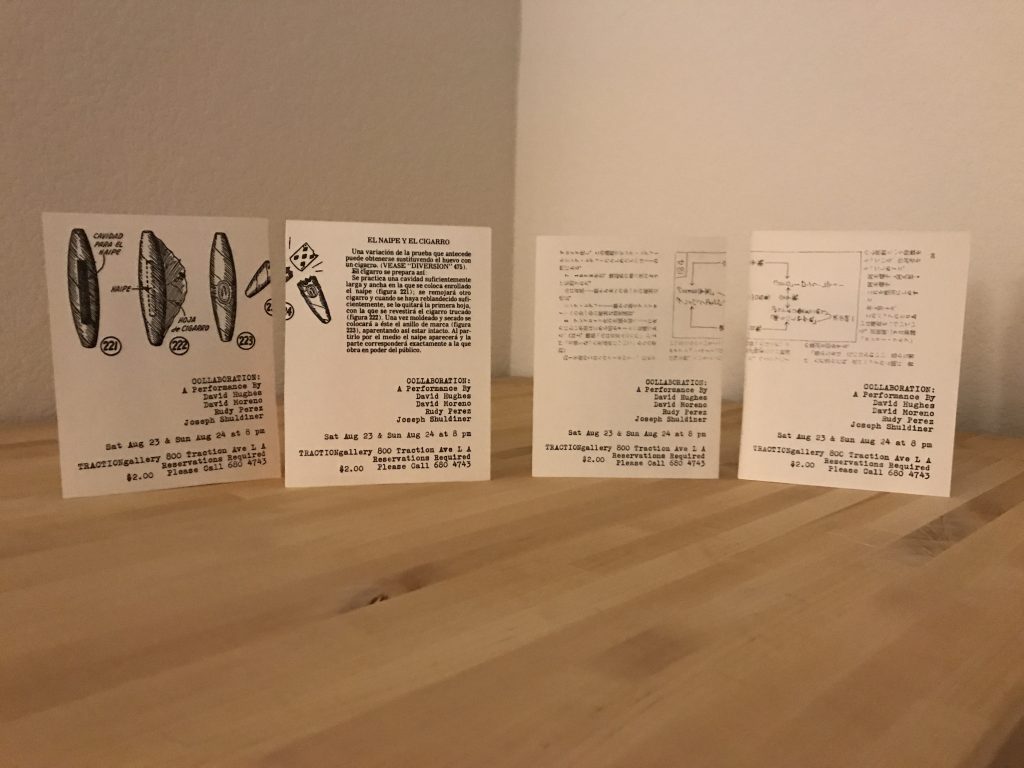
L.A. 200, later named Images and Delusions of L.A., was a bicentennial mail art show at Traction Gallery that opened September 4, with the contribution of, among others, Jerry Dreva, whom Joseph had met in a graphic design work-study program conducted by LAICA and federally subsidized by CETA (Comprehensive Employment and Training Act).1
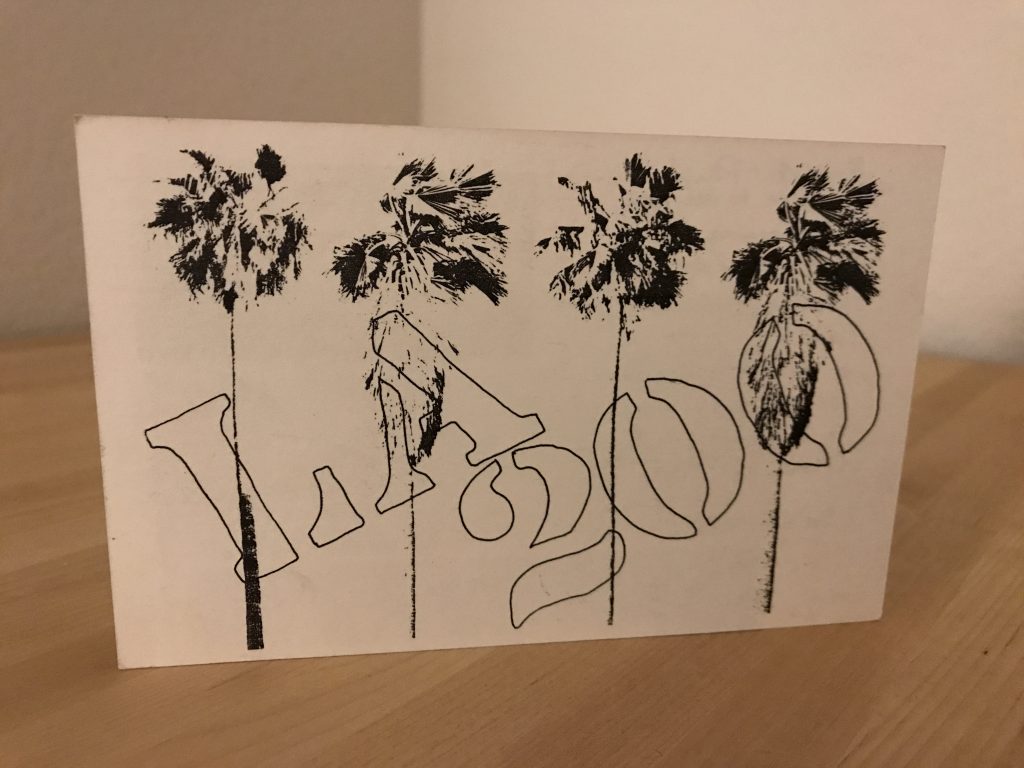
Coincidentally, the day after the mail art show opened, Rudy presented another collaboration—with composer Lloyd Rodgers and visual artists Phil Garner and Mark Stock at LAICA’s downtown space.2
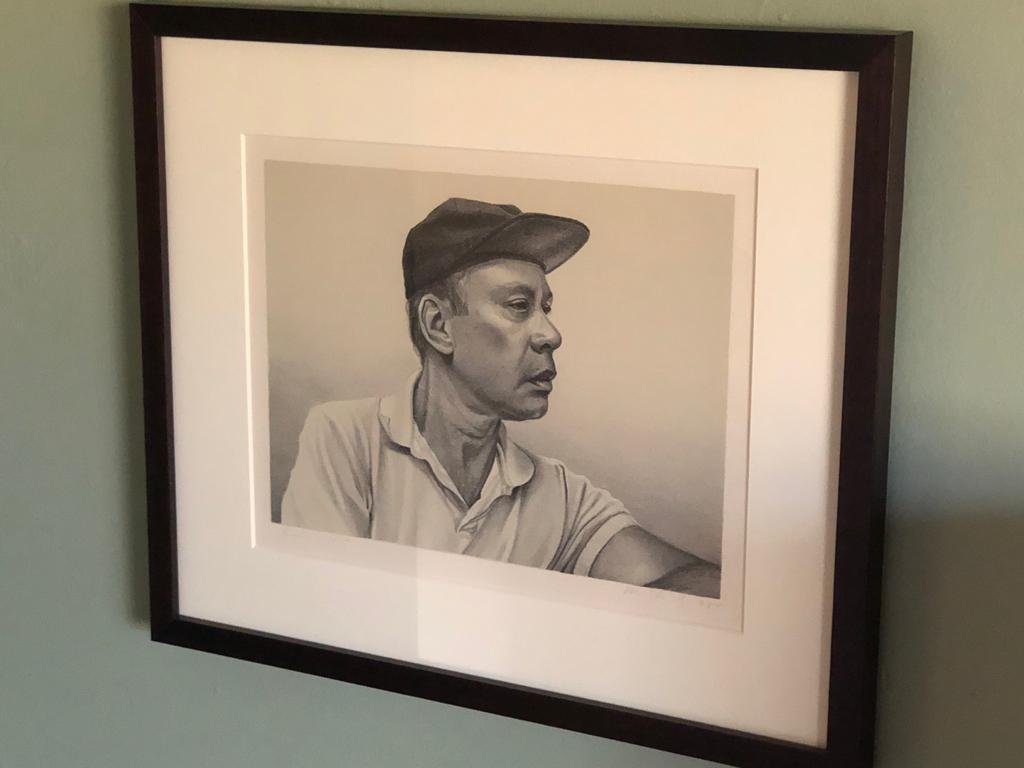
And a week later, on September 12, Rudy Perez Dance Theater appeared in Dance Kaleidoscope ’80 at the John Anson Ford Theater in Hollywood, presenting a new work titled, mm…, New Dance, which might have satisfied at least one critic (about which more below).3
I asked Rudy how the three of us at Traction came to work with him on Urban Rite. He said he was very interested in the art that was coming out of downtown L.A. and it’s likely he attended David’s Aqua and chatted him up.
An Anatomy of Collaboration
From my initial notes:
-
- Opening Image: Chairs
- [Audiot]ape of chairs
- (Chair piece) = w/ film?
- Dancing Ban in China
- Ritual Piece – Fetish(es) – too serious?
- [American] Indian Dance – Rudy
- Wrappings – Joseph
- Construction Piece – David [Moreno]
This was fleshed out in a second set of notes. The titles are as they appear in the event program; notes have been expanded for clarity.
-
- Chairs covered by drop cloth, painter’s artist’s cloth; slides projected on drop cloth; sound effects: construction sounds, chair sounds at end; David M w/ mask gives chairs to audience members
- Introduction to “Sacred Ground” – David Moreno, from a work in progress (sound excerpt from Gamba – David Hughes4): Construction Ritual w/ live mechanical sounds & tape loop [vocal loop from Gamba]; in the dark; LIGHTS!!; T A B L E A U X; T R A N S I T I O N (20 min.)
- Running Board – Rudy Perez: American Indian dance piece – Rudy (1:24) w/ construction barrier lights (flashing); 12000 Silence → Airport (1:00) → children’s chant [actually Tibetan Buddhist chanting from His Holiness Dardo Trulku Rinpoche and the Gelugpa Order] (2:36) → airport (1:25; 4:05 together)
- Tremors – David Hughes: AiR (retitled Tremors) – Sound piece (3:00 min.)
- Last Breath – Joseph Shuldiner: W R A P P I N G S (original title) – Dark – Silence – Bamboo chopstick sounds on the ground – Lights come up – Feed Plastic / Open Door / Close Door (20 min.); audio consisted of the initial “gong” from Herbert Eimert’s text sound masterwork Epitaph für Aikichi Kuboyama (1957–1962); multi-tracked chanting from Tibetan Buddhism Tantras of Gyütö: Mahakala and a multi-tracked solo voice from Shomyo-Buddhist Ritual from Japan; final audio posted here
- Dancing Ban in China – Rudy Perez/David Hughes (Andrea Carney – speaker): Track 1 Very high-pitched tiny sounds à la Mekons [this could have applied to Tremors above], 2 Very soft glass chimes sounds, 3 Wine glass, 4 Loop, 5 Loudspeaker “drums”; final audio posted here 5
I reconnected with David Moreno this month and asked him for any recollections of the performance. His reply:
I remember such random pieces about Urban Rite… except that I was strongly inspired by the cliff dwellers of the Southwest which I had been drawn to even as a kid. This was all before moving to New Mexico. I liked seeing the ancient in the contemporary. There is a tantrik saying that “whatever is here has always been here and what isn’t here will never be here….”
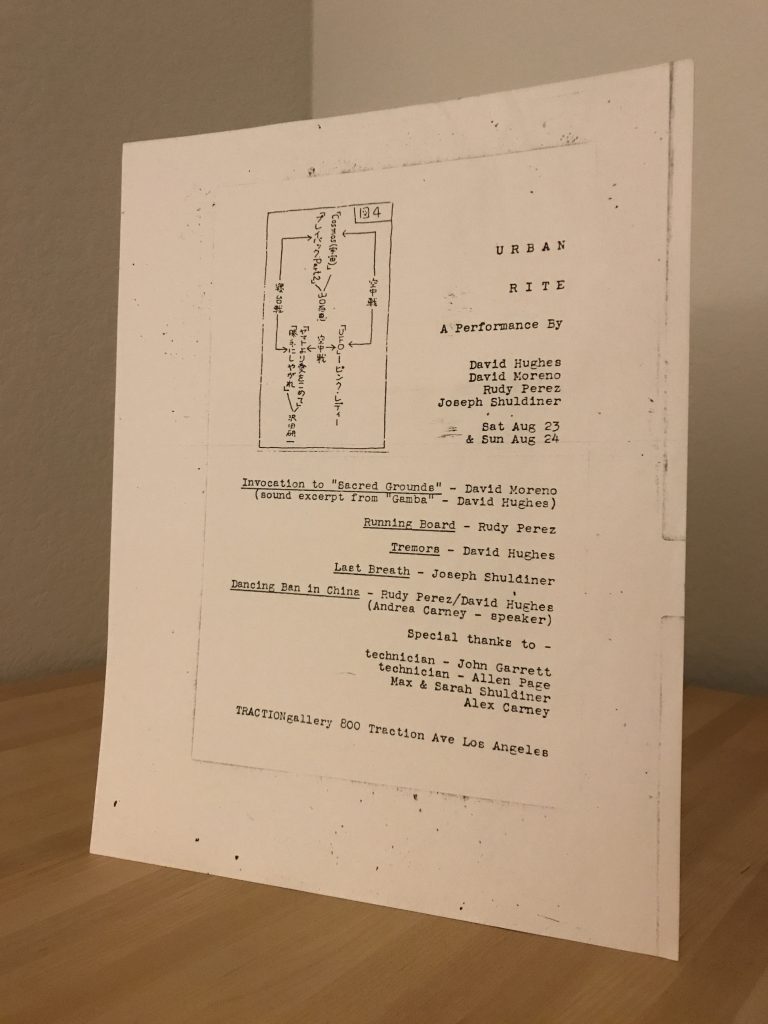
The Eyewitness
Dance critic Martin A. David reviewed Urban Rite in the pages of Drama-Logue three weeks after the performance:
If, as the pundits of culture are nosing about, the newly hatched ’80s will resemble, to some extent, the highly heralded ’60s, the place to see it first is in the arts. It is a bit early to predict, with less than one-tenth of the new decade squeezed from the tube, but modern dance is showing some signs of leaning into the winds of dissent and exploration which blew through that turbulent time.
Urban Rite, a collaborative effort by local artists Joseph Shuldiner, David Moreno, David Hughes and Rudy Perez (one of the “names” of the so-called New York dance explosion of the ’60s), at the Traction Gallery in downtown Los Angeles, was a timid showing of some of those signs.
The work, composed of five interflowing segments, would probably more comfortably be labeled “happening” or “performance art” than dance by many people, but the same was true of much of the work shown at the Judson Church or the Bridge Theatre in the ’60s.
Indeed, Urban Rite originally was billed as “movement/performance,” as noted on the flyer above, and as “performance” later.
Most successful of the segments was David Moreno’s opening Invocation to “Sacred Grounds.” The audience was admitted to a white-walled space which was filled with irregularly shaped constructions of various heights covered with crisp white plastic. Slide projections on the walls and on the shapes showed the skeletal construction process of skyscrapers juxtaposed with images of mountain cliffs and those of simpler constructions by more primitive humans. A hooded, loinclothed figure (Moreno) with two twig-broom rattles guided the audience in wordlessly. He showed us where to sit and then guided several people to unveil the mounds. They were constructed of stacked chairs which were placed according to the ghostly figure’s directions and the audience spread out to sit in the more formal theatre atmosphere.
Rudy Perez’ Running Board followed. The work seemed not like a reminder of that earlier dance time, but rather a leftover from it. It opened with a hydraulic lift motoring in somberly, accompanied by three men in construction coveralls and hard hats. The others left and Perez performed alone, running a nervous slalom between three beer cans, playing with a long rope which had a rag doll noosed at the end, and walking the twisted path of the rope. The piece lacked new research and new conclusions, but it was presented as new; as if, not being in New York and not being in the ’60s, we hadn’t seen it all before.
Audiences had seen Running Board before. It was Rudy’s adaptation of his Running Board for a Narrative, which debuted at Marymount Manhattan College in 1973. The next performance took place at CU in Boulder in 1974, a year after I had left there for Los Angeles. Two more iterations were presented in New York in 1974 and 1976 before Rudy relocated to Los Angeles in 1978.6
The other segments of the ritual, Tremors, Last Breath and Dancing Ban in China suffered generally from a lack of focal clarity and of appropriate energy distribution.
I wish Martin David had suffered us a little more, because neither I nor Rudy have any memory of what either of us did in Tremors or Dancing Ban in China aside from the audio. Martin David ends, however, with an image from Joseph’s Last Breath:
One moment, in which the performers strung the space with a seemingly endless length of clear polyetheline [sic] plastic, was particularly symbolic of the transition taking place in the downtown area around the gallery. Industries are moving out and artists are moving in. (Traction Gallery itself is in a former factory building). [sic] The twisted and rejected bits and bolts found in the dumpsters around the remaining factories are quickly salvaged and transformed by the artists. The process is repeating.7
Appendix
In response to Part 2 of our interview, Rudy forwarded this reminiscence from visual artist Jim Morphesis:
Rudy, your appearance on the Rona Barrett show was absolutely wonderful and it was indeed the day that we first met. I remember it well and I have told the story many times over the years. You may not recall this, but that day you were being chauffeured in a limo driven by my then brother-in-law, Tom. You were running late and concerned that you might miss seeing yourself on the RB show, so Tom drove you to our nearby home just in time for your appearance on the show. Tom, his sister Kathy, who was my wife at the time, and myself were excited to meet you and we all had a delightful time together. Now, the story becomes rather bittersweet. Some weeks ago, Tom contracted the virus. There were complications and sadly, he died. I have remained close to both Tom and Kathy over the years. Recently, Kathy and I reminisced about better times when we were together with Tom and, of course, our surprise meeting with the famous Rudy Perez came up and we had a chance to remember and smile. Rudy, I certainly didn’t want to depress you with this story. I just wanted you to know that our first meeting meant more than you could know.
Later, as I was preparing this post, I ran across the following exhibition announcement, which I’d forgotten. It was held in early 1982.
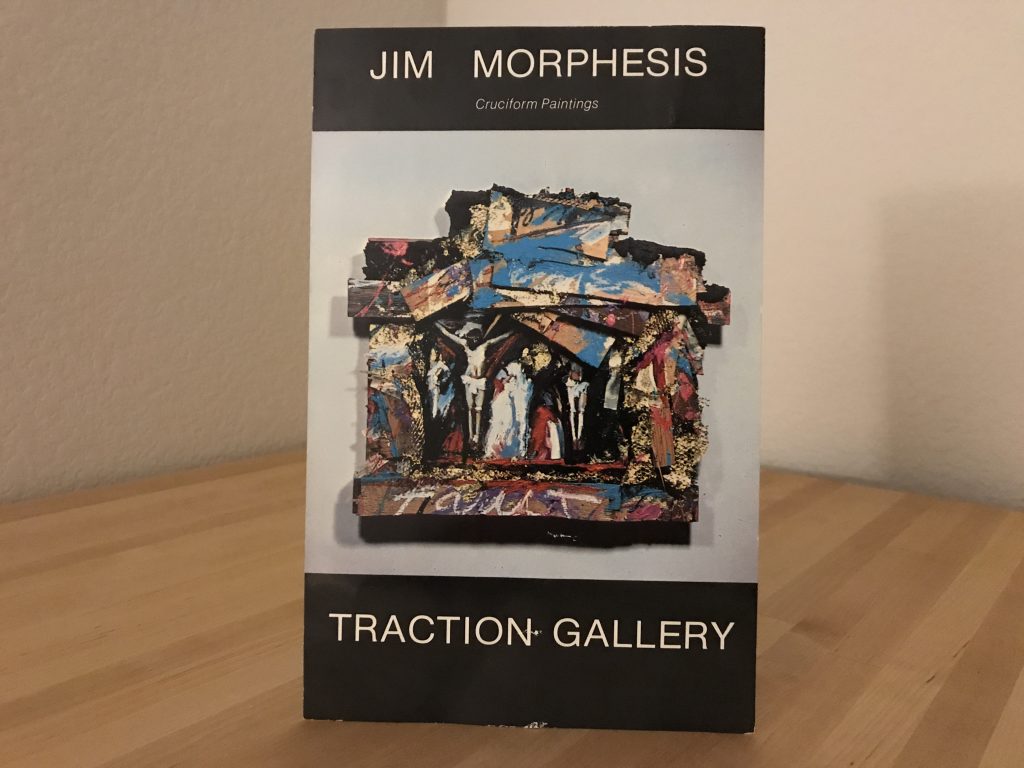
In the Wikipedia entry for Morphesis, author and journalist Peter Clothier summarizes: “[Morphesis’s] early work was characterized by its brooding, dramatic strength, its juxtaposition of structural formality with expressive intensity, its crusty, abstract surfaces which always seemed to reveal less than they concealed.” Clothier’s remark appeared in his review “Jim Morphesis at Traction Gallery.”8
Not everyone has the luxury of conversing with an artist to discuss what’s revealed and concealed. I’m grateful that Morphesis is open to my comments and questions. As is the case with No Sanctuary, about which I opined:
(Which led me to recognize his own triptychs, Colmar Variations, which use the altarpiece architecture more literally.)
He also added:
[O]ur Traction Gallery connection is a nice surprise. The exhibition space that Joe and David put together on Traction Ave. was a venue that helped launch the prominence of LA’s downtown art scene in the 1980s. I loved working with Joe and David and my exhibition there turned out to be an important one for me.
And my work there as well.
Notes
- The program’s classes were held at LAICA’s satellite gallery, 815 Traction. See classified ads for both CETA and non-CETA jobs, L.A. Weekly, 14–20 Sep 1979, 43.
- “Mixed-Arts Program at LAICA” and “Wit Links Dancer, Two Visual Artists,” Los Angeles Times, 05 and 09 Sep 1980 respectively, VI 5. Rudy’s solo Take Stock was reprised only once, at UCLA’s Royce Hall on 17 Jan 1981 (see Rudy’s repertory documentation).
- “Good Times: Dance Kaleidoscope,” L.A. Weekly, 11 Sep 1980; Rudy’s repertory documentation.
- My sound piece Gamba premiered on 20 Apr 1980 as part of a private performance-rite and publicly on 17 Aug 1980 as part of my Aches.
- Thank you to Nicki Coyle for her speedy digital transfer of these tracks from the original tapes.
- See Rudy’s repertory documentation.
- Martin A. David, “Dance Spectrum” [column], Drama-Logue, 18–24 Sep 1980, n.p.
- Art in America, Vol. 70 (Summer 1982), 149.


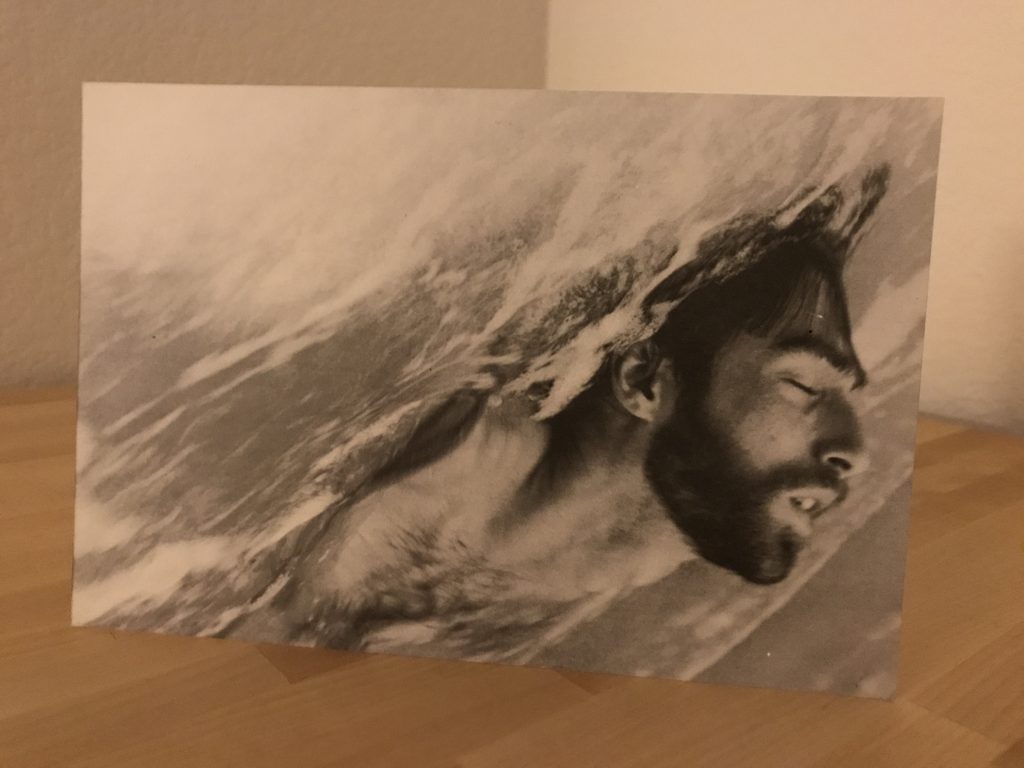
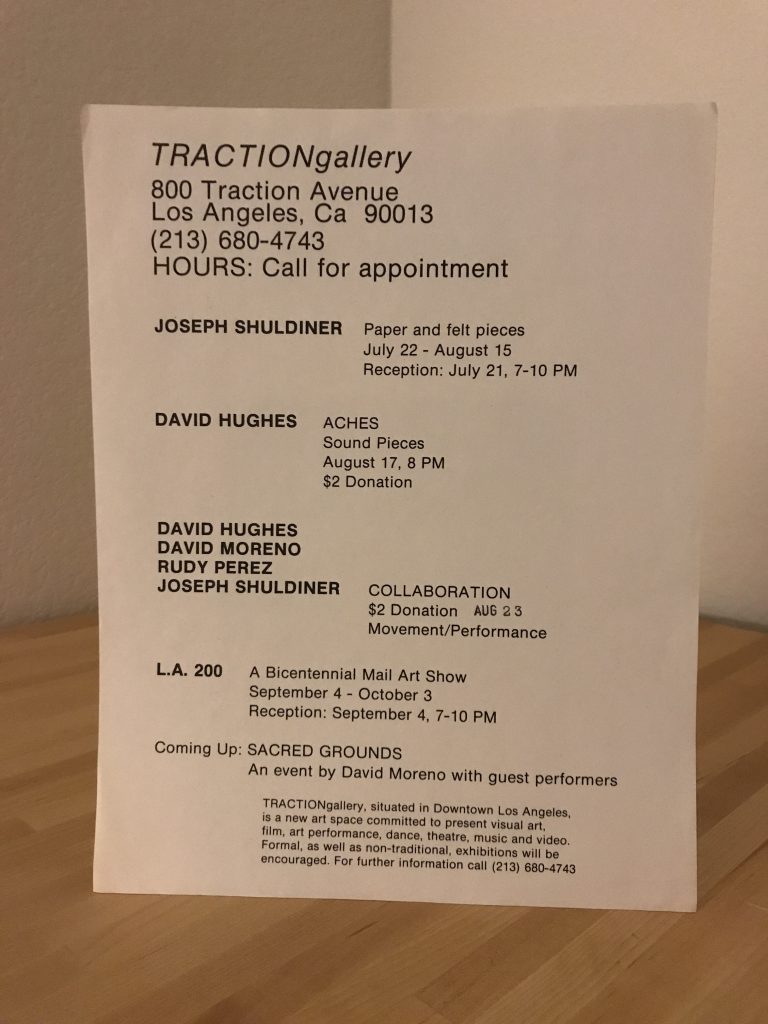
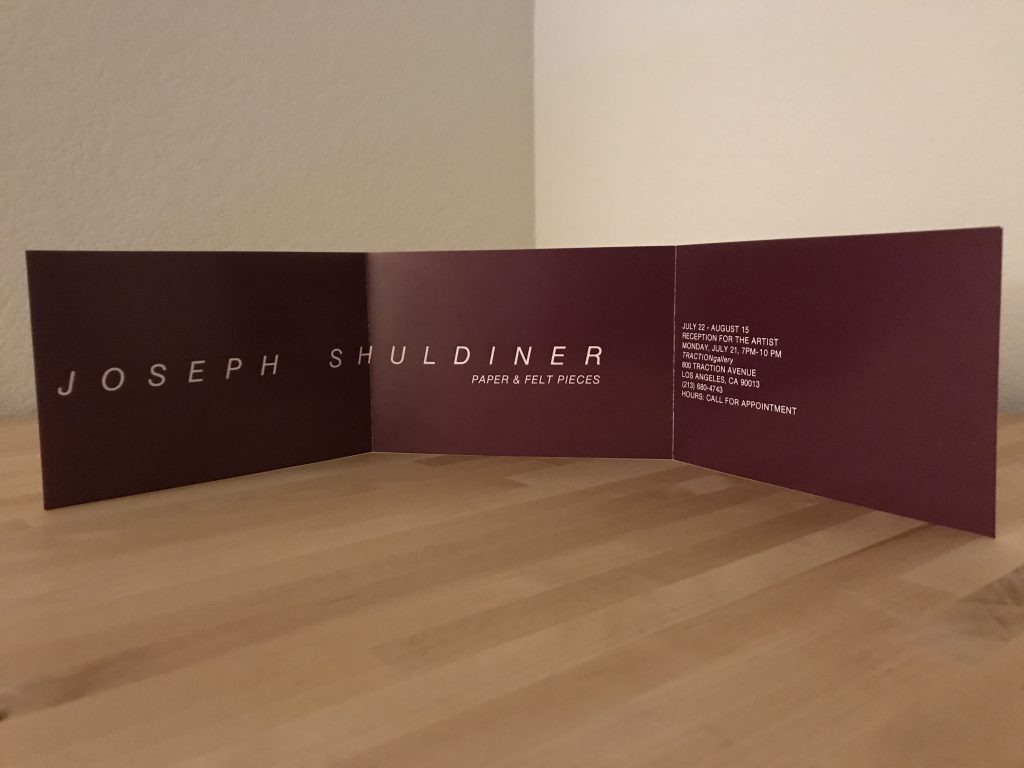
One Reply to “Portrait of Rudy Perez 3: Anatomy of a Performance”